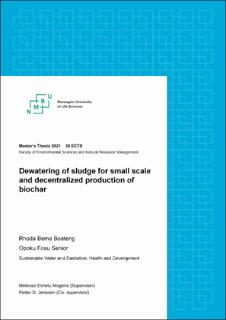| dc.description.abstract | Sewage sludge dewatering and drying is one of the major challenges in the current wastewater treatment systems. The current dewatering methods in centralized wastewater treatment plants whether using frame or belt filter press or centrifuges are energy intensive and requires up to 50% of the cost of wastewater treatment. The moisture content of the sludge cake after dewatering is also a key factor in determining the efficiency of sludge handling and utilization including energy efficiency and pollutant emission. This is even more challenging for decentralized sludge management aiming at resource recovery and local resource utilization from the perspective of circular economy. To overcome these challenges, an experiment was designed to develop an alternative sludge dewatering and drying method for decentralized wastewater treatment systems and local production of sludge-based biochar. Raw sludge was collected from Frogn Renseanlegg, a wastewater treatment plant in Drøbak, in Viken county of Norway. The sludge was filtered in the laboratory using a solid-liquid separation system containing a 200µm and 100µm mesh integrated with sand filtration to remove free water through gravity to produce a sludge cake. The effect of different percentages of Wood pellets (WP), Spent Coffee Grounds (SCG) and different mixture of the two as bulking agents for deep-dewatering (removal of tightly bound water) was investigated without energy input. The percentages of Wood Pellets (WP) and Spent Coffee Grounds (SCG), varied from 0% (control) to 20% by weight of the raw sludge. The moisture content of the mixture was determined at an average temperature of 17°C after 1, 24, 48, 72 and 96 hr. In the experiment, sludge with addition of 5% SCG, 10% SCG and 20% SCG had an average moisture content of 71.1%, 66.0% and 46.0%, respectively, after 96 hours. For 5% WP, 10% WP and 20% WP, the average moisture content after 96 hours were 70.3%, 55.9% and 45.6%. Adding a small amount of superabsorbent facilitated reduction of the amounts of SCG and WP and achieved a moisture content reduction down to 9.0% after 72 hours. The removal of tightly bound sludge water and fast drying in sludge conditioned with WP and SCG may be mainly explained by absorption by the amendment and subsequently a better porosity and larger surface area for evaporation. | en_US |

